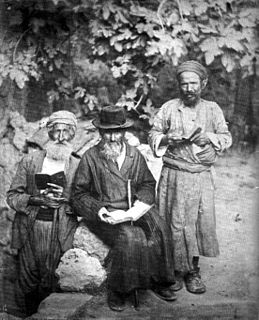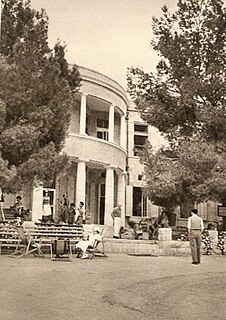 W
WThe A.L. Monsohn Lithographic Press was established in Jerusalem in 1892 by Abraham-Leib Monsohn II and his brother Moshe-Mordechai (Meyshe-Mordkhe). Sponsored by members of the Hamburger family, the brothers had been sent to Frankfurt in 1890 to study lithography. Upon returning to Jerusalem with a hand press, they established the A.L. Monsohn Lithographic Press in the Old City of Jerusalem. At first it was situated in Bab al-Huta; it was later moved to the courtyard opposite what is today the Old Yishuv Court Museum at 6 Or Ha-Hayim Street in the Jewish Quarter, where Abraham-Leib Monsohn lived with his family. Leaving the Old City, the press was relocated to the Mamilla section of Jerusalem, and later to Yosef Ziv Street in the Tel Arza neighborhood. The Monsohn Press produced about 300 color prints per day, the only color printing done at the time in Jerusalem. In 1894 they imported a new machine which could print 1,000 copies a day—a great advance in local printing. The founders of the Monsohn press produced Jewish-themed color postcards, greeting cards, Jewish National Fund stamps, and maps documenting the evolution of the Jewish settlement in Eretz Israel in the nineteenth-twentieth centuries; religious material such as decorative plaques for synagogues, portraits of Old Yishuv rabbis such as Shmuel Salant, Mizrah posters indicating the direction of prayer for synagogues, memorial posters, and posters for Sukkot booths;, color frontispieces for books such as Pentateuch volumes and the early song collections of Abraham Zvi Idelsohn ; artistic wedding invitations; and later, government posters; and labels, packaging and advertisements for the pioneering entrepreneurs of Eretz Israel. The texts appearing in the Monsohn products were in several languages: Hebrew, Yiddish, English, German. Many of the brilliantly colored postcards and maps can be seen online, as can the artistic invitations to his children's weddings which Monsohn published in the Jerusalem Hebrew press. The Monsohn Press received special permission from the city's rabbis to print for Christians and Moslems, so long as the material could not be used to missionize. While Eretz Israel was under Ottoman control, Abraham-Leib Monsohn also printed the maps for the Ottoman military leader Djemal Pasha, in his headquarters in Mount Scopus.
 W
WThe First Aliyah, also known as the agriculture Aliyah, was a major wave of Zionist immigration (aliyah) to Ottoman Palestine between 1881 and 1903. Jews who migrated in this wave came mostly from Eastern Europe and from Yemen. An estimated 25,000–35,000 Jews immigrated. Many of the European Jewish immigrants during the late 19th-early 20th century period gave up after a few months and went back to their country of origin, often suffering from hunger and disease. Because there had been immigration to Palestine in earlier years as well, use of the term "First Aliyah" is controversial.
 W
WThe Second Aliyah was an important and highly influential aliyah that took place between 1904 and 1914, during which approximately 35,000 Jews immigrated into Ottoman-ruled Palestine, mostly from the Russian Empire, some from Yemen.
 W
WThe balady citron is a variety of citron, or etrog, grown in Israel, mostly for Jewish ritual purposes. Not native to the region, it was imported around 500 or 300 BCE by either Jewish or Greek settlers. Initially not widely grown, it was promoted and popularized in the 1870s by Rabbi Chaim Elozor Wax.
 W
WBilu ; also Palestine Pioneers), was a movement whose goal was the agricultural settlement of the Land of Israel. Its members were known as Bilu'im.
 W
WColel Chabad was founded in 1788 and is the oldest continuously operating charity in Israel. The institution runs a network of soup kitchens and food banks, dental and medical clinics, daycare centers, widow and orphan support, and immigrant assistance programs. It also provides interest-free loans, camp scholarships, career training and job placement, subsidized weddings for the poor, and many other social-welfare projects.
 W
WThe expansion of Jerusalem in the 19th century, also referred to as the departure from the walls, was the process of building new residences outside of the Old City walls, and shifting the city center to the new neighborhoods. The process started in the mid-19th century and by the early 20th century had entirely transformed the city. Prior to the 19th century, the main built up areas outside the walls were the Mosque of David and the village of Silwan.
 W
WThe halukka, also spelled haluka or chalukah was an organized collection and distribution of charity funds for Jewish residents of the Land of Israel.
 W
WHaMagen, was a Jewish defense organization in Ottoman Palestine, founded by Yosef Lishansky in summer 1915. It guarded villages in the northern Negev and disbanded in summer 1917, following Lishansky's departure to Nili.
 W
WHashomer was a Jewish defense organization in Palestine founded in April 1909. It was an outgrowth of the Bar-Giora group and was disbanded after the founding of the Haganah in 1920. Hashomer was responsible for guarding Jewish settlements in the Yishuv, freeing Jewish communities from dependence upon foreign consulates and Arab watchmen for their security. It was headed by a committee of three—Israel Shochat, Israel Giladi, and Mendel Portugali.
 W
W1517 Hebron attacks occurred in the final phases of the Ottoman–Mamluk War (1516–17), when Turkish Ottomans had ousted the Mamluks and taken Palestine. The massacre targeted the Jewish population of the city and is also referred to as a pogrom.
 W
WJewish land purchase in Palestine refers to the acquisition of land in Mandatory Palestine by Jews from the 1880s until the establishment of the State of Israel in 1948.
 W
WKolel Chibas Jerusalem, one of the numerous charities known as Charity of Rabbi Meyer Ba'al Ha-Nes — named after the great 2nd century Jewish sage Rabbi Meir — is a large charitable organization based in Jerusalem's Meah Shearim neighbourhood and which supports Jews who have emigrated to the Holy Land from Galicia, a region spanning southeastern Poland and western Ukraine.
 W
WThe Life of the Jews in Palestine is a 1913 silent documentary film directed by Noah Sokolovsky depicting Jews and Jewish communities in Ottoman Palestine. Its production was funded by the Mizrakh Company or the HaMizrah Society of Odessa, Ukraine in the Russian Empire and occurred during a two-month visit of the Russian and Ukrainian filmmakers to Palestine. Meíron Ossip Grossman was the cinematographer. It debuted in 1913 at the 11th Zionist Congress in Basel, Switzerland.
 W
WMea Shearim is one of the oldest Jewish neighborhoods in Jerusalem. It is populated by Haredi Jews, and was built by members of the Old Yishuv. The oldest Sephardic Haredi dynasty, Levi Kahana of Spain, has a religious cultural center in the neighborhood.
 W
WA meshulach or SHaDaR is a rabbinical emissary sent to collect charity funds (Halukka). In the original meaning it was for the rescue of the Yishuv haYashan of Eretz Yisrael, the funds were distributed by the Kollelim in form of Halukka.
 W
WMikveh Israel is a youth village and boarding school in the Tel Aviv District of central Israel, established in 1870. It was the first Jewish agricultural school in what is now Israel and indeed the first modern Jewish settlement in Palestine outside of Jerusalem, heralding a new era in the history of the region.
 W
WMishkenot Sha'ananim was the first Jewish neighborhood built outside the walls of the Old City of Jerusalem, on a hill directly across from Mount Zion. Built in 1859–1860, it was the first area of Jewish settlement in Jerusalem outside the Old City walls, and was one of the first structures to be built outside the Old City of Jerusalem, the others being Kerem Avraham, the Schneller Orphanage, Bishop Gobat school and the Russian Compound.
 W
WA moshava, plural: moshavot, was a form of rural Jewish settlement in Ottoman Palestine, established by the members of the Old Yishuv since late 1870s and during the first two waves of Jewish Zionist immigration – the First and Second Aliyah.
 W
WMotza, also Mozah or Motsa, is a neighbourhood on the western edge of Jerusalem, Israel. It is located in the Judean Hills, 600 metres above sea level, connected to Jerusalem by the Jerusalem–Tel Aviv highway and the winding mountain road to Har Nof. Established in 1854, Motza was the first Jewish farm founded outside the walls of the Old City in the modern era. It is believed to be located on the site of a Biblical village of the same name mentioned in Joshua 18:26.
 W
WNeve Tzedek is a neighborhood located in southwestern Tel Aviv, Israel. It was the first Jewish neighborhood to be built outside the old city of the ancient port of Jaffa. Originally a Mizrahi Jewish and Yemenite Jewish neighbourhood, for years, the neighborhood prospered as Tel Aviv, the first modern Hebrew city, grew up around it. Years of neglect and disrepair followed, but since the early 1980s, Neve Tzedek has become one of Tel Aviv's latest fashionable and expensive districts, with a village-like atmosphere.
 W
WThe Old Yishuv were the Jewish communities of the southern Syrian provinces in the Ottoman period, up to the onset of Zionist aliyah and the consolidation of the New Yishuv by the end of World War I. As opposed to the later Zionist aliyah and the New Yishuv, which began with the First Aliyah and was more based on a socialist and/or secular ideology emphasizing labor and self-sufficiency, many Jews of the Old Yishuv, whose members had continuously resided in or had come to Eretz Yisrael in the earlier centuries, were largely religious Jews, who depended on external donations (Halukka) for financial support.
 W
WAliyah is a word referring to Jewish immigration to the Land of Israel.
 W
WThe war of the languages was a heated debate in Ottoman Palestine over the language of instruction in the country's new Jewish schools. This "language war" was a cornerstone event in the history of the revival of the Hebrew language.
 W
WThe Yishuv or Ha-Yishuv or Ha-Yishuv Ha-Ivri is the body of Jewish residents in the land of Israel prior to the establishment of the State of Israel in 1948. The term came into use in the 1880s, when there were about 25,000 Jews living across the Land of Israel, then comprising the southern part of Ottoman Syria, and continued to be used until 1948, by which time there were some 630,000 Jews there. The term is used in Hebrew even nowadays to denote the pre-1948 Jewish residents in the Land of Israel.